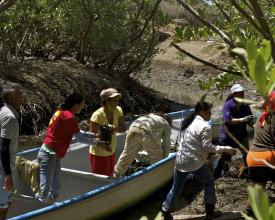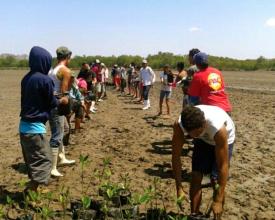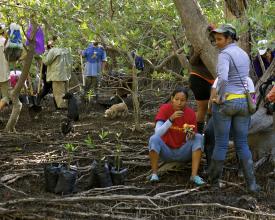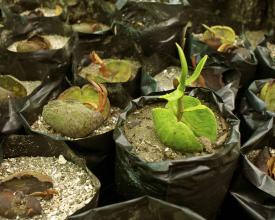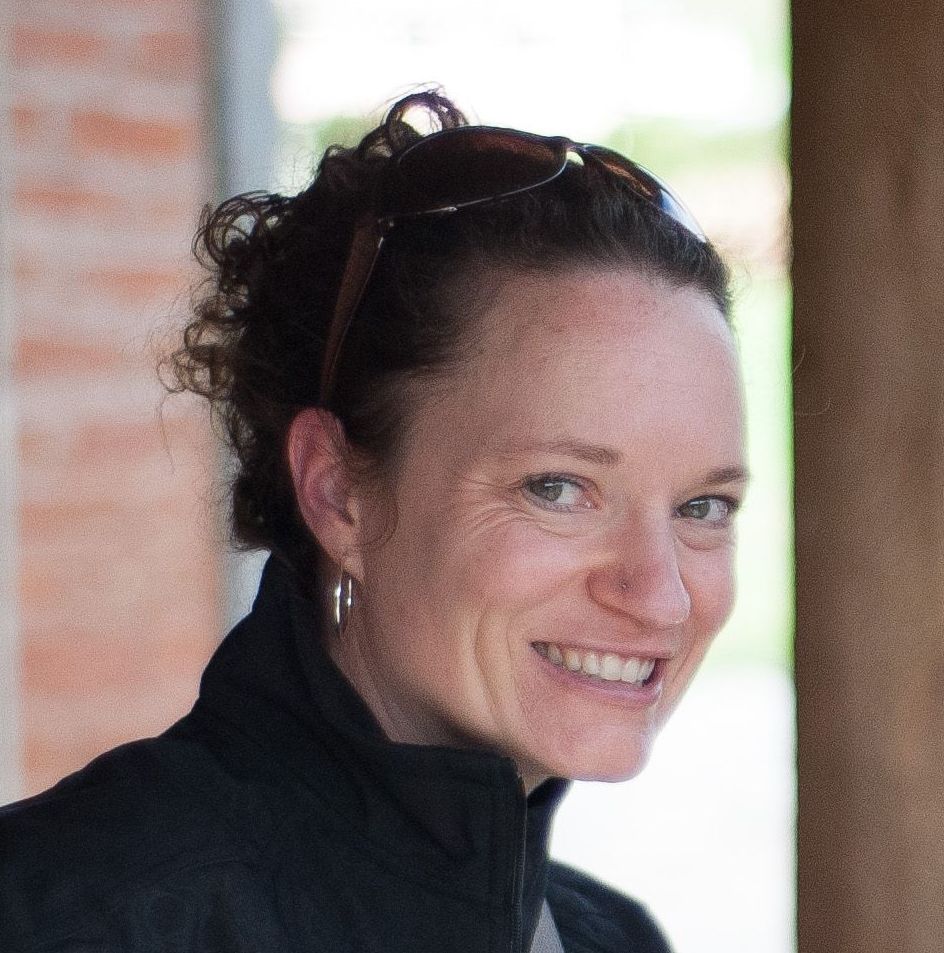Garantizar los medios de subsistencia mediante la conservación y restauración de los manglares
Solución completa
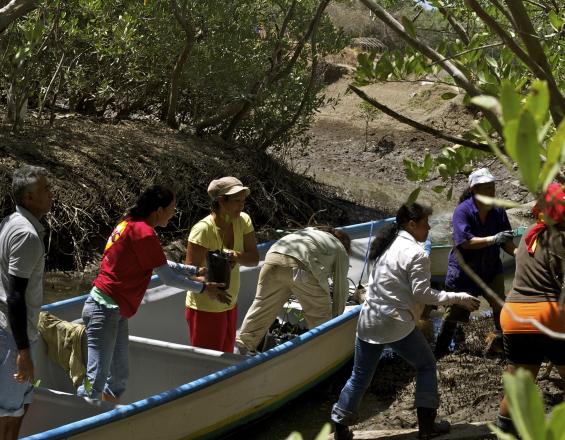
Miembros de la comunidad trasladan plantones de mangle a un bosque degradado, donde los plantarán
©Marco Quesada / Conservation International
La solución "Asegurar los medios de subsistencia" aborda las causas profundas de la pérdida y degradación de los manglares en el Golfo de Nicoya, prestando especial atención a las repercusiones resultantes en las comunidades locales. La solución incluye la elaboración de políticas, la capacitación de microempresarios locales para aumentar el uso sostenible de los manglares y diversificar los medios de vida de la comunidad, la restauración de los manglares por parte de los interesados locales y un programa de educación local para las escuelas.
Última actualización: 24 Sep 2025
5732 Vistas
Contexto
Défis à relever
Pérdida y degradación de los manglares La deforestación y degradación de los manglares se debe a la recolección excesiva de leña y a su conversión en estanques de evaporación de sal y de camarones. Los medios de subsistencia costeros dependen en gran medida de la pesca, que está directamente vinculada a la salud de los manglares. Además, las partes interesadas locales y los responsables políticos no conocen bien la importancia de los servicios ecosistémicos de los manglares.
Ubicación
Golfo de Nicoya, Costa Rica
América Central
Procesar
Resumen del proceso
Esta solución se ha extraído de los resultados de campo obtenidos en 2014. En general, todos los componentes del proyecto se basaron en la ciencia y se vieron afectados por los conocimientos de las partes interesadas y los responsables políticos locales. Este enfoque de "conocimientos combinados" favoreció la consecución de todos los objetivos del proyecto. En cuanto a la ejecución del proyecto, la participación activa de las partes interesadas locales se vio facilitada por la relación de trabajo y confianza existente con Conservación Internacional y la elevada inversión de tiempo sobre el terreno, lo que permitió una colaboración y un intercambio de conocimientos continuos. Esto último facilitó la comunicación de los resultados y enseñanzas del proyecto a diversos niveles de público local, subnacional y nacional.
Bloques de construcción
Diseño basado en la ciencia
La mejor ciencia disponible se adaptó a las condiciones locales en forma de métodos de investigación y actividades de campo (es decir, enfoque de la replantación comunitaria de manglares). Tanto la literatura científica como los científicos locales participaron en el diseño y la aplicación de nuestro enfoque. Nos basamos en la experiencia y los conocimientos científicos internacionales y nacionales para diseñar las zonas que debían deforestarse (estudios aéreos, cartografía SIG, imágenes por satélite) y las especies que debían replantarse (en función de la zonación natural de los manglares estudiada).
Además, el enfoque para implicar a las partes interesadas locales se basa en experiencias similares registradas en Filipinas. En relación con la estimación del Carbono Azul, utilizamos los métodos acordados por un grupo internacional de científicos del Carbono Azul, y estos métodos fueron aplicados por científicos locales. La estimación fue dirigida por un experto científico en la materia y siguió las directrices internacionales, y se contrató a un botánico para dirigir las labores de replantación de los manglares.
Factores facilitadores
- Relación de trabajo/confianza existente con las comunidades locales - Experiencia nacional existente - Capacidad local
Lección aprendida
En general, la implicación de las partes interesadas se llevó a cabo con una elevada inversión de tiempo y el desarrollo de una amplia relación de colaboración (más allá de los objetivos del proyecto).
El hecho de que las estimaciones del carbono azul se hayan realizado siguiendo un método científico reconocido facilita la publicación, el intercambio y la presentación de los resultados a audiencias y organismos internacionales como el Grupo Intergubernamental de Expertos sobre el Cambio Climático (IPCC) y la Convención Marco de las Naciones Unidas sobre el Cambio Climático (CMNUCC).
Partes interesadas activas en todos los niveles
Trabajamos con las partes interesadas locales en todos los niveles del proyecto. Gracias al firme compromiso de las mujeres locales en particular, las partes interesadas, bajo la orientación de un experto, asumieron la responsabilidad de cuidar y replantar más de 8.000 plantas de manglar. Las partes interesadas locales también participaron en la capacitación de microempresarios turísticos y se puso en marcha un programa educativo en tres escuelas. La clarificación previa de los valores e intereses que motivan a los interesados locales resultó clave en el diseño y la ejecución del proyecto. Invertir mucho tiempo en trabajar con las comunidades y apoyarlas es fundamental para su éxito. En general, la ciencia se integró en toda la participación de las partes interesadas, incluido el programa educativo. Entre las actividades específicas cabe citar la utilización de los conocimientos actuales para presentar el valor de los manglares a los niños locales; el diseño y la ejecución del programa de replantación; y la presentación de las evaluaciones del carbono azul (es decir, la investigación científica) a los responsables políticos locales.
Factores facilitadores
- Relación de trabajo/confianza existente con las comunidades locales - Elevada inversión de tiempo/trabajo de campo y seguimiento de resultados - Capacidad local
Lección aprendida
El éxito de este enfoque radica en el firme compromiso de las mujeres locales, en particular, y de los pescadores de la isla de Chira, en el golfo de Nicoya. Invertimos mucho tiempo en las comunidades, trabajando con ellas y apoyando su trabajo, en lugar de hacer que apoyaran "nuestro" proyecto. La clarificación previa de los valores e intereses que motivan a los interesados locales resultó clave en el diseño y la ejecución del proyecto. Creemos que un proyecto sobre el terreno tiene que comprender y tener en cuenta los intereses y valores de las partes interesadas locales e incluirlos en las actividades que se planifican para conseguir resultados concretos, significativos y duraderos.
Informar los procesos políticos
A nivel nacional, los resultados del componente de Carbono Azul, como el presupuesto de carbono para los manglares del golfo de Nicoya y una estimación actualizada de la deforestación, se presentaron a los responsables de la toma de decisiones como una forma de informar la elaboración de políticas sobre estrategias más amplias de mitigación del cambio climático dirigidas a múltiples servicios ecosistémicos.
Factores facilitadores
A cargo del proveedor de la solución.
Lección aprendida
A cargo del proveedor de la solución.
Impactos
La replantación de manglares en este proyecto tuvo un éxito de supervivencia superior al 90%. El diseño basado en la ciencia y el compromiso de la comunidad resultaron clave para lograr este resultado, incluida una medición de referencia completa del secuestro de carbono en los manglares de Nicoya, un programa educativo para escolares y una evaluación de la superficie total de manglares existente en el golfo. Costa Rica protege por ley todos los manglares del país desde finales de los años setenta. Este es un factor que ha reducido, aunque no detenido, la degradación del ecosistema de manglares.
Los interesados locales asumieron la responsabilidad de cuidar y replantar más de 8.000 plantas de mangle en zonas degradadas cercanas a sus comunidades. Más de 260 niños participaron en clases mensuales sobre manglares y biología marina. Se crearon dos viveros de manglares que fueron gestionados con éxito por los interesados locales.
Beneficiarios
pescadores artesanales, comunidades costeras y responsables políticos nacionales
Historia
Los manglares del Golfo de Nicoya, un sistema estuarino muy productivo de la costa pacífica de Costa Rica, sufrieron una presión cada vez mayor en las décadas de 1950 y 1960, cuando fueron despojados para obtener leña y convertidos en estanques de evaporación de sal y de camarones. Aunque estas presiones aún no se han cobrado zonas importantes de los manglares de Costa Rica, la degradación de estos ecosistemas puede resultar costosa a escala local y nacional. La expansión de los estanques de camarones y salinas, así como la expansión de la agricultura, siguen siendo amenazas en Costa Rica.
Los manglares proporcionan múltiples beneficios, tanto a nivel local para las comunidades costeras de Nicoya, que dependen de la pesca directamente vinculada a la salud de los manglares, como a nivel mundial. Las complejas raíces de los mangles ralentizan el flujo del agua, lo que permite que los sedimentos se acumulen y almacenen enormes cantidades de carbono (a menudo llamado carbono azul), más que los bosques terrestres.
Cuando decidimos poner en marcha un proyecto piloto de reforestación de manglares, un grupo de mujeres de la isla de Chira fueron las primeras en decir que sí. Durante cinco meses, un grupo de 23 mujeres limpiaron de redes y plásticos enredados una zona de manglares cercana a su comunidad. Después empezaron a plantar semillas de mangle en bolsas que llenaban a mano con arena y sedimentos, regando estas plantas dos veces al día. Las mujeres hicieron todo este trabajo de forma voluntaria sin dejar de ocuparse de sus obligaciones familiares cotidianas. En Chira, las mujeres desempeñan un papel importante en la crianza de los hijos, el cuidado de la casa y la búsqueda de otras fuentes de ingresos. Sus maridos, en su mayoría pescadores artesanales, dependen de los manglares para pescar peces, que viven en su interior cuando son jóvenes y dependen de ellos para alimentarse cuando son adultos. En una isla donde las oportunidades de trabajo son escasas, las mujeres reconocieron el potencial del proyecto para atraer turistas e incluso la atención de organismos gubernamentales que, con el tiempo, podrían remunerar su tiempo y energía. Un año después de empezar, habían replantado más de 8.000 plantas de mangle en zonas degradadas, con una tasa de supervivencia superior al 90%. Otras comunidades de la isla se inspiraron y empezaron sus propios proyectos de replantación. Han recibido visitas de responsables de organismos gubernamentales e incluso de turistas. Los responsables políticos también han sido testigos de la dependencia de las comunidades costeras de los manglares, y ahora son conscientes del enorme sumidero de carbono que representan los sedimentos de las zonas de manglares. En una época en que el cambio climático y la sobrepesca parecen ser omnipresentes, los manglares ofrecen esperanza a quienes dependen de ellos directa e indirectamente.
Conectar con los colaboradores
Otros colaboradores
Marco Quesada
Conservación Internacional
Ana Gloria Guzmán
Conservación Internacional
